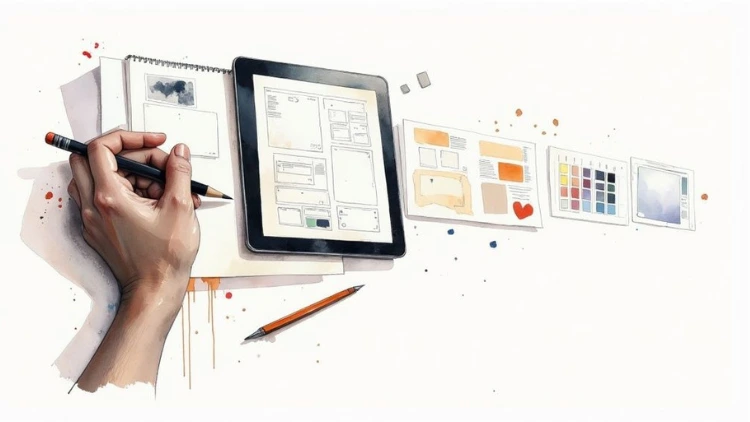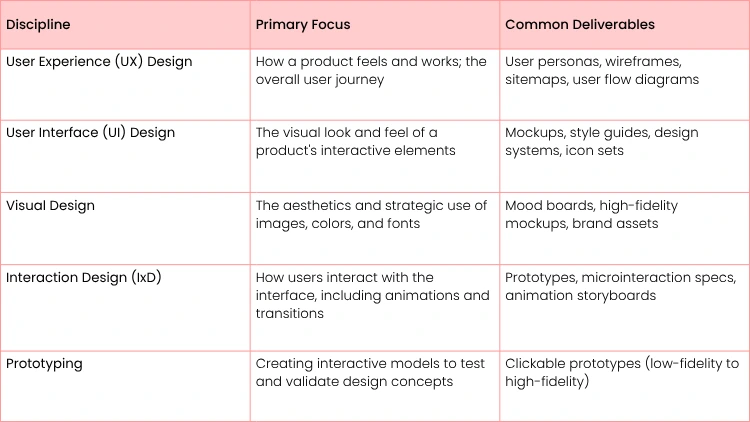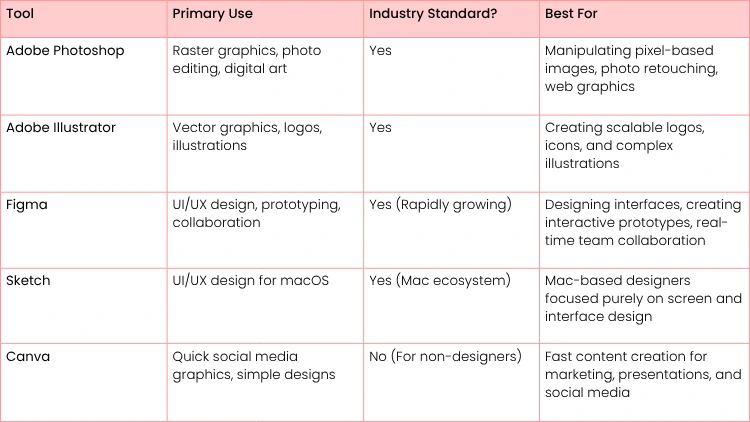Choosing a Digital Design Course That Works For You

A digital design course is a structured program that teaches you how to bring ideas to life on screens—think websites, mobile apps, and social media. It's a blend of classic graphic design principles and modern tech, with a heavy focus on making things not just beautiful but also incredibly easy to use. This is where you learn the craft of creating for the digital world.
Think of it as the bridge between raw creativity and the technology we interact with every day. It’s where timeless concepts like color theory, typography, and composition meet the practical demands of building engaging online experiences. In a way, you're training to become a digital architect.
Jump To Section

Earn As You Learn
Earn 25% commission when your network purchase Uplyrn courses or subscribe to our annual membership. It’s the best thing ever. Next to learning,
of course.
Who Is This Course For?
It's a common myth that you need to be a seasoned artist or have a formal art degree to get into digital design. The truth is, these courses are built for a wide range of people who are ready to learn practical, in-demand skills.
A great digital designer is both an artist and a problem-solver. The goal isn't just to make something look good; it's to make it work seamlessly for the person on the other side of the screen.
This kind of program is a perfect fit for:
- Career Changers: People from fields like marketing, administration, or customer service who are looking for a more creative and technical career path.
- Traditional Artists & Graphic Designers: Creatives with a background in print or fine arts who want to modernize their skills for the screen.
- Marketing Professionals: Marketers who need to create more effective digital campaigns, social media content, and websites that truly connect with an audience.
- Aspiring Freelancers: Anyone who wants to build a flexible career, working with different clients on exciting projects from anywhere in the world.
If you have a creative spark and an interest in how technology works, you can absolutely find your place here. These courses provide a structured path to turn that interest into a profession, which is a hallmark of the modern digital era of courses where learning is more accessible than ever.
Core Disciplines in Digital Design
Instead of just making a pretty picture, you learn to design entire systems that people interact with. This means shifting your focus from just stunning visuals to creating intuitive interfaces that guide someone effortlessly from point A to point B. At the heart of this are User Experience (UX) and User Interface (UI), so it’s worth getting a handle on what UI/UX design is before diving in.
The table below breaks down the key disciplines you'll encounter, showing how they fit together to create a complete digital product.
Each of these areas is a specialty in its own right, but a great digital design course will give you a solid foundation in all of them so you can see the bigger picture.

What You'll Actually Learn in a Digital Design Course
Jumping into a digital design course is a bit like learning the grammar of a new visual language. Before you can craft compelling stories—or in this case, design apps and websites people love to use—you have to get the fundamentals down cold. These core principles are the timeless rules that separate confusing digital noise from experiences that just feel right.
Every solid curriculum starts with the bedrock of design theory. These aren't just fluffy, academic ideas; they're the practical tools you’ll pull from your toolkit every single day. Think of them as a chef's essential ingredients—you can't create a masterpiece without them.
The Unchanging Fundamentals of Design
The heart of any real design education rests on three pillars. Nail these, and your work won't just look good—it'll be functional, clear, and effective.
- Color Theory: This is so much more than just picking pretty colors. You'll dive into the psychology behind color—understanding why blues build trust for a banking app or how a splash of red creates urgency for a "buy now" button.
- Practical Example: A course project might involve creating a color palette for a new wellness app. You'd choose calming greens and soft blues to evoke health and serenity, and then create a "style guide" document that specifies the exact color codes for developers to use.
- Typography: Typography is the subtle art of making words easy and enjoyable to read on a screen. You'll discover why a clean, sans-serif font like Helvetica is a workhorse for body text, while a more elegant serif font might be perfect for a luxury brand's logo.
- Actionable Insight: Learn to establish a clear visual hierarchy. Use a large, bold font for your main headline (H1), a slightly smaller one for subheadings (H2), and a legible, standard-sized font for body paragraphs. This simple trick instantly makes your content easier to scan and understand.
- Layout and Composition: This is all about arranging things on a screen to create balance, harmony, and a clear path for the user to follow. You’ll use principles like the rule of thirds to place a key image or button in the most powerful spot on a webpage. These skills are universal, forming the foundation of everything from a simple social media post to a complex software dashboard. If you want to build a really strong foundation here, a dedicated graphic design course can give you an even deeper understanding.
Specializing in User-Centric Skills
Once you've got a solid grip on the fundamentals, the course shifts into the specialized skills that companies are desperate to hire for right now. This is where you start applying those foundational rules to solve real problems for actual digital products. The focus moves from just "how it looks" to "how it looks and works".
This part of your journey is all about the user. Let's be honest, a beautiful app that nobody can figure out is a failure. You'll learn how to build empathy for the people you're designing for, putting their needs at the absolute center of every decision you make.
The best designs are born from a deep understanding of the user. It's about stepping into their shoes to create an experience that feels like it was made just for them, solving their problems before they even have to think about them.
Bridging UI and UX Design
The two big specializations you'll hear about constantly are User Interface (UI) and User Experience (UX) design. They’re different, but they're completely intertwined, and a great digital design course will show you exactly how they dance together.
User Interface (UI) Design is the "what". It’s the visual stuff you can see and interact with.
- Practical Example: You might get an assignment to design the checkout screen for an online store. This means creating buttons that are obviously clickable, intuitive form fields for shipping details, and a clean layout for the order summary. Your job is to make the interface look great and be instantly easy to use.
User Experience (UX) Design is the "why" and the "how". It’s the entire feeling a person gets when using the product from start to finish.
- Actionable Insight: For that very same checkout screen, a UX designer would first map out the entire customer's journey. They'd be asking questions like: Is it simple to edit the shopping cart? Are there too many steps? Can the user save their address for next time? The goal is to make the whole process smooth, frustration-free, and maybe even a little delightful.
A top-tier digital design course teaches you to be both the architect (UX) and the interior designer (UI). You learn how to build a rock-solid structure that works perfectly, then apply a beautiful, consistent visual layer on top. The end result is a product that doesn't just work—it connects with people.
Mastering The Modern Designer's Toolkit
A great designer with the wrong tools is like a world-class chef with a dull knife. The talent is there, but the execution will always feel like a struggle. That’s why any digital design course worth its salt is built around mastering the software that actually powers the creative industry. This isn't just about memorizing shortcuts; it's about intuitively knowing which tool to grab to bring a vision to life, efficiently and professionally.
Let’s be honest: the software landscape can feel overwhelming, but a few giants really run the show. Adobe's Creative Suite is practically synonymous with digital design, commanding over 80% of the global market. This means that getting fluent in programs like Photoshop, Illustrator, and InDesign isn’t just a nice-to-have skill—it's the baseline expectation for most creative jobs.
With the U.S. expected to add 23,900 new designer jobs each year, knowing your way around these tools is your ticket into the industry.
The Industry-Standard Software Suites
At the heart of almost every design curriculum, you’ll find the core Adobe applications. Each one plays a unique and critical role in a designer's day-to-day workflow.
- Adobe Photoshop: While it started as a photo editor, Photoshop is now the undisputed king of pixel-based images. You'll use it for everything from touching up product photos for an e-commerce site to creating stunning digital art for a social media campaign. A huge part of this is learning to optimize images for the web, where you’ll need to know how to reduce file size of photos without losing quality.
- Adobe Illustrator: This is where vector graphics live. Unlike pixels, vectors are built on mathematical equations, which means you can scale them from the size of a postage stamp to a giant billboard without any loss in quality. Think about it: a company logo has to look sharp everywhere, and Illustrator is what makes that possible.
The Rise of Collaborative UI and UX Platforms
While Adobe is the standard for creating graphics, the world of app and web design has been completely shaken up by collaborative, browser-based tools. The leader of this new wave is Figma, a platform that has quickly become the go-to for UI/UX teams everywhere.
Figma’s real power lies in its collaborative nature. It turns the design process from a solitary activity into a live, team-based workshop, allowing designers, developers, and stakeholders to work together in real-time.
A major focus in any modern design course will be teaching you how to build interactive prototypes in tools like Figma. You’ll learn how to connect screens, animate transitions, and create a clickable mock-up of an app that looks and feels just like the final product. This is an absolutely essential step for user testing and getting everyone on board before a single line of code gets written. If you want to dive deeper, we break down why this is so critical in this guide on what is user experience design.
Accessible Tools and Emerging Technologies
Beyond the heavy hitters, a well-rounded designer also knows how to use more accessible tools for quick-turnaround projects. Platforms like Canva have democratized design, and understanding how to use them strategically for social media posts or simple marketing materials is a surprisingly valuable skill.
On top of that, new AI assistants are starting to change how designers work. These tools can help brainstorm ideas, generate mood boards, or automate tedious tasks. A forward-thinking course will introduce you to these technologies not as a replacement for your creativity, but as powerful assistants that can speed up your process and unlock new possibilities. You'll walk away with a toolkit that is both powerful today and ready for whatever comes next.
Essential Digital Design Software Comparison
To help you get a clearer picture of the landscape, we've put together a quick comparison of the most common software taught in digital design courses. This should give you a sense of what each tool does best and why it's become an industry staple.
Each of these tools has its place, but a solid course will focus on the professional-grade software—Photoshop, Illustrator, and Figma—that hiring managers are looking for.

Turning Your New Skills Into a Career
Finishing a digital design course is a huge milestone, but let's be honest—it's just the starting line. The real prize is turning all that newfound knowledge about typography, user research, and prototyping into a career you actually enjoy. This is the moment you stop thinking like a student and start acting like a professional problem-solver.
The design world is buzzing with cool-sounding roles, but the titles can get confusing. It's so important to look past the job title and get a feel for what the day-to-day work actually involves. At their core, each role is about solving a different kind of problem.
Common Career Paths in Digital Design
Your skills can pull you in a few different directions. While you'll find plenty of overlap between roles, each one has its own unique flavor. Here are some of the most common paths for digital design grads.
- UX/UI Designer: This is a classic combo, especially at smaller companies or startups. You might spend Monday wireframing a new app feature (that's the UX part) and Tuesday designing the icons and color scheme for it (the UI part).
- Product Designer: Think bigger picture. A product designer is involved from the very beginning to the very end—from user research and strategy sessions to the final pixel-perfect polish and checking in on how it's performing after launch. They're the glue between engineers and product managers, making sure the product not only works but also hits its business targets.
- Visual or Communication Designer: This role is all about the fundamentals of graphic design. You could be creating an entire brand identity for a new company, designing eye-catching marketing materials, or crafting beautiful social media graphics that stop people from scrolling.
The demand for these skills is definitely there. The global graphic design market, a huge piece of this puzzle, was valued at over $43.4 billion in 2025. In the United States, the industry is expected to pull in $11.3 billion in revenue that same year. But with more designers entering the field, the competition is getting fierce, which makes having specialized skills from a great course more critical than ever.
Your Portfolio: The Ultimate Career Asset
No matter which path you take, one thing is absolutely non-negotiable: your portfolio. It’s the single most important thing you will create. A certificate says you learned something; a portfolio proves you can do the work.
Your portfolio is your professional story. It should do more than just display pretty pictures; it must demonstrate your thought process, your problem-solving abilities, and the tangible impact of your design decisions.
Hiring managers are busy. They might only spend a few minutes flipping through your work, so you have to make it count. That means showing them not just the polished final product, but the messy, thoughtful journey it took to get there.
Actionable Steps to Build a Standout Portfolio
Think of your portfolio as its own design project. Kick things off with the best work you did in your course, then aim to add two or three more solid case studies to round it out.
- Lead with a Strong Case Study: Pick a project that shows off your full range of skills.
- Practical Example: A complete redesign of a local coffee shop's mobile ordering app.
- Tell the Story: Don’t just throw up the final screens. Walk them through it. Start with the problem you were trying to solve (e.g., "The original app had a clunky and confusing checkout flow"). Show your research, your rough sketches, and explain why you made certain design choices.
- Show Your Impact: If you can, add numbers. Even if it's a concept project, you can run some quick usability tests and say something like, "Testing with five users showed a 40% reduction in the time it took to complete an order."
- Consider Freelancing for Experience: The best way to get real-world projects is to... well, do real-world projects. Taking on a few small freelance jobs is an amazing way to build out your portfolio. For a full rundown on finding your first clients, check out this guide on how to start a freelance business.
When you focus on great storytelling and showing real results, your portfolio stops being just a gallery of your work. It becomes the key that unlocks the door to your first job in design.

How to Choose the Right Digital Design Course
With so many digital design courses out there, picking the right one can feel like a design project in itself. The trick is to look past the flashy marketing and zero in on what actually builds job-ready skills. Let's walk through a practical framework you can use to vet any program and find one that truly lines up with your career goals.
Think of yourself as a detective. You’re hunting for clues that prove a course’s real value, starting with evidence that its curriculum teaches the tools and processes companies are using right now.
Scrutinize the Curriculum and Tools
A great curriculum is a direct reflection of the current industry. The syllabus shouldn't just list topics; it should clearly outline how those skills fit into a professional workflow. Vague promises are a red flag—you need to see the specifics.
Look for a heavy emphasis on industry-standard software. For instance, any modern course worth its salt must have a significant module dedicated to Figma. It’s the undisputed go-to for UI/UX teams, so proficiency isn't just a bonus, it's a requirement.
Here’s a quick checklist for analyzing a syllabus:
- Modern Tools: Does the course prioritize Figma for UI/UX, alongside essentials like Adobe Illustrator and Photoshop for visual design?
- UX Process: Is there a clear, dedicated section on the end-to-end UX process—from user research and journey mapping to wireframing?
- Prototyping Skills: Does it explicitly teach how to build interactive, high-fidelity prototypes? This is how you'll test and present your designs.
- Real-World Projects: Are the projects framed as practical case studies (like "design a mobile banking app") instead of just abstract exercises?
A curriculum that ticks these boxes is built to get you hired, not just to teach you theory. Thinking critically about how a course is structured is key.
Evaluate Mentorship and Instructor Support
Let’s be honest: self-paced videos are great, but they can't replace personalized feedback from someone who's been in the trenches. The quality of mentorship can be the single biggest factor in your growth. It’s how you learn to see your own work with a critical eye and push past those inevitable creative blocks.
A great mentor doesn't just tell you what's wrong with your design; they ask the right questions to help you discover the solution yourself. This builds the problem-solving muscle you'll need for your entire career.
When you're looking at a course, dig into the details of their support system.
- Actionable Insight: Look for mentions of live feedback sessions, where an instructor actually reviews your work in real-time. This is infinitely more valuable than a simple pass/fail grade.
- Practical Example: A program might offer weekly "office hours" where you can book a 15-minute one-on-one to get help on a specific project challenge. That kind of direct access is a game-changer.
Don't settle for a generic email support inbox. You want a program that weaves human interaction and personalized guidance right into the learning fabric. That hands-on coaching is what turns a beginner into a confident pro.
Assess Career Services and Job Support
At the end of the day, you're taking a digital design course to launch or level up your career. That means career support isn't just a nice-to-have—it's a core part of the program's value. Strong career services show that a school is truly invested in your success after you graduate.
Look for tangible, specific offerings that connect the classroom to your first paycheck. Vague promises of "job support" should make you skeptical. What you really want is a structured system designed to make you a standout candidate.
Here’s what truly valuable career support looks like:
- Portfolio Reviews: The program should include multiple, deep-dive portfolio reviews with industry pros who give direct, actionable feedback on how to best present your projects.
- Interview Preparation: Look for services like mock interviews and coaching on how to talk through your design process. This is a critical skill for acing interviews.
- Hiring Partner Networks: The best programs have built relationships with companies and can connect graduates directly with hiring managers who are actively looking for new talent.
Choosing the right course is a strategic move. By carefully analyzing the curriculum, mentorship, and career services, you can cut through the noise and find a program that delivers the skills, support, and connections you need to build a real career in design.
Your Action Plan for Becoming a Digital Designer
Feeling that spark of inspiration is a fantastic start, but turning it into a real-deal career takes a solid plan. Let's take all that momentum you're feeling right now and channel it into a simple, three-step launchpad to get you going in digital design today. This isn't just about reading another article; it's about kicking off a career with some actual confidence.
Step 1: Immerse Yourself in the Design World
Before you even think about committing to a digital design course, you need to start training your eye. Seriously, the single best way to learn what great design looks like is to surround yourself with it. This builds up your internal visual library and helps you develop your own sense of taste and a gut feeling for what works.
A super practical way to do this is by making professional portfolio platforms your new hangout spot.
- Actionable Insight: Spend 20 minutes a day—maybe with your morning coffee—browsing sites like Behance and Dribbble. Don't just mindlessly scroll. Really look at the work. Ask yourself: What makes this layout feel so clean? How does that color choice make me feel about the brand?
Look at the sheer variety of styles and projects. This is your new classroom. Making this a daily habit is a low-effort, high-impact way to start absorbing design principles before you ever crack open a textbook.
Step 2: Get Your Hands Dirty with Free Tools
Alright, next up: it’s time to switch from being a spectator to a creator. You don't need to drop cash on a full course just to find out if you actually enjoy doing the work. Getting hands-on is the quickest way to figure out which parts of design really get you excited.
The most powerful way to confirm your passion for design is to make something—anything. The act of creating, even on a small scale, will tell you more than weeks of research ever could.
Fire up some accessible, free tools and follow a few tutorials. Just get a feel for the process.
- Practical Example: Find a beginner's tutorial on YouTube for a tool like Figma and try building a simple mobile app screen. Or, jump into Canva and design a social media post for a fake coffee shop. The goal here isn't to create a masterpiece; it's just to play and explore.
Step 3: Shortlist Your Top Course Options
Once you've dabbled a bit and confirmed that, yes, this design thing is definitely for you, it's time to get serious about your education. Go back to that checklist we talked about earlier for choosing the right program. Use it to cut through the noise and shortlist just two or three courses that genuinely fit your budget, your schedule, and what you want to achieve.
This focused approach keeps you from getting overwhelmed and helps you make a smart, strategic choice that you'll feel good about.
Common Questions About Digital Design Courses
Thinking about jumping into a new career is a big step, and it always comes with a lot of questions. If you're looking at digital design, you're probably wondering about a few key things. Let's clear up some of the most common uncertainties so you can move forward with confidence.
Do I Need an Art Degree to Succeed in Digital Design?
Absolutely not. While a background in art or drawing can be a plus, it’s far from a requirement. Digital design is really about solving problems for people—it’s just as much about psychology and understanding users as it is about making things look good.
A solid digital design course will teach you all the core principles you need, starting from square one. The focus is on practical application, not stuffy art theory. Many of the best designers today come from totally different fields like marketing, hospitality, or even psychology. What really matters is your ability to empathize with users and think strategically, not whether you can sketch a perfect portrait.
Is a Portfolio More Important Than a Certificate?
This one comes up all the time. The simple answer is that you really need both. Think of it this way: a certificate gets your foot in the door by proving you’ve gone through structured training. But your portfolio is what seals the deal—it's the undeniable proof that you can actually do the work.
A certificate gets your resume noticed, but a strong portfolio gets you hired. Hiring managers want to see your thought process and the quality of your work, not just a credential.
Here's how to think about it: Treat every single project in your course like it’s going into your portfolio. Don't just show the final product. Document your entire journey—the initial research, the messy sketches, the user feedback you received, and how you landed on the final design. That story is what makes a portfolio truly stand out.
How Long Does It Take to Get a Job After a Course?
There’s no magic number, but most graduates who are actively building their portfolio and making connections land their first job within three to six months of finishing their course. The biggest factor here is you. Students who wrap up their program with a polished portfolio and have practiced talking about their work are in the best position to find a job quickly.
Your success after the course really comes down to the effort you put in. This includes:
- Constantly refining your portfolio and adding new projects.
- Getting active on platforms like LinkedIn and connecting with people in the industry.
- Customizing your resume and cover letter for every single job you apply for.
Your course gives you the skills and the foundation, but it's that post-graduation hustle that actually lands you the job.
Ready to stop wondering and start building? Uplyrn offers expert-led courses with mentorship and career support designed to get you job-ready. Explore our digital design programs and kickstart your creative career today.


Leave your thoughts here...
All Comments
Reply